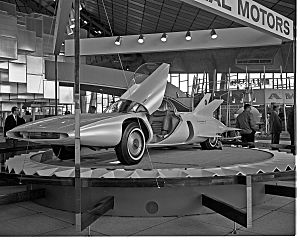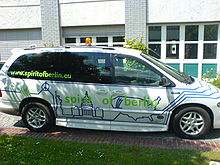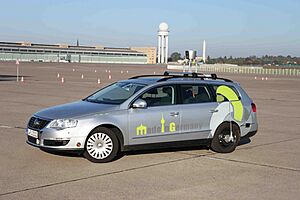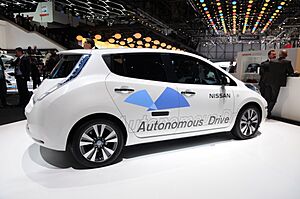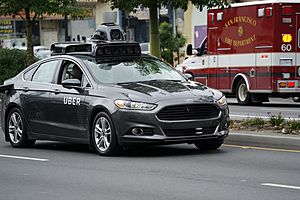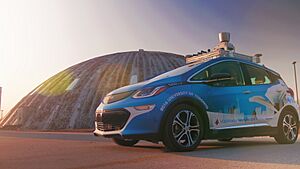History of self-driving cars facts for kids
Imagine a car that can drive itself! Self-driving cars, also known as autonomous vehicles, are cars that can sense their surroundings and move without a human driver. They use special technology like cameras, radar, and computers to understand the road, traffic, and obstacles. Scientists and engineers have been working on these amazing vehicles for many years, hoping to make travel safer and easier for everyone.
The idea of cars driving themselves has been around for a long time. Early experiments with self-driving cars began way back in 1939. By the 1980s, the first truly independent self-driving cars started to appear. Projects like Navlab at Carnegie Mellon University and the Eureka Prometheus Project in Europe showed that cars could navigate on their own. Since then, many big companies like Mercedes-Benz, Google, and Toyota have joined the effort to develop these futuristic cars.
Today, some countries and regions, like parts of Europe, the UK, and Japan, have started to create rules for automated cars. This means that testing and even some limited use of self-driving cars are now allowed in certain areas. For example, in Japan, laws were updated in 2020 and 2023 to allow more advanced self-driving features on public roads.
Contents
History of Self-Driving Cars

Early Ideas (1920s-1930s)
The dream of self-driving cars started to become real in the 1920s. In 1925, a company called Houdina Radio Control showed off a "radio-controlled" car in New York City. It was a 1926 Chandler car that someone in another car controlled with radio signals. This early experiment had some bumps, literally, as the car crashed into a sedan!
In the 1930s, the idea of automated cars was shown at the 1939 World's Fair. An exhibit called "Futurama," sponsored by General Motors, displayed electric cars that were guided by radio signals and moved by special fields in the road. The designer, Norman Bel Geddes, even wrote a book predicting that humans wouldn't need to drive by 1960.
Wired Roads and Early Tests (1950s-1960s)
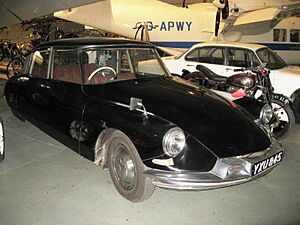
In the 1950s, RCA Labs created a system where a small car was guided by wires on a lab floor. This idea inspired engineers in Nebraska to try it on a real highway. In 1957, RCA Labs and the State of Nebraska successfully showed a full-sized car guided by wires buried in the road. This system could even tell if other cars were nearby.
General Motors also showed off its "Firebird" concept cars during this time. These cars had an "electronic guide system" that would let the driver relax while the car drove itself on special highways.
In the 1960s, research continued. Ohio State University worked on cars activated by electronic devices in the road. The UK's Transport and Road Research Laboratory tested a driverless Citroen DS car that followed magnetic cables in the road. This car could drive at 80 miles per hour without human help, even in bad weather!
Cameras and Computers (1970s-1980s)
In the 1970s, research focused on using signals from cables to control cruise control. While funding for these projects eventually stopped, the idea of smart cars kept growing. Stanford University even had a small robot car that accidentally drove onto a nearby road!
A big step forward happened in Japan in 1977. The Tsukuba Mechanical Engineering Laboratory designed the first self-driving car that didn't need wires under the road. It used two cameras and early computer technology to "see" and process information.
The 1980s brought even more progress. In Germany, a team led by Ernst Dickmanns created a vision-guided Mercedes-Benz van that could drive at nearly 60 miles per hour on empty streets. The DARPA-funded ALV project in the U.S. used new technologies like lidar (which uses lasers to measure distance) and computer vision to guide robotic vehicles. By 1989, Carnegie Mellon University started using neural networks (computer systems inspired by the human brain) to control self-driving cars.
Cross-Country Journeys (1990s)
The 1990s saw some impressive demonstrations. In 1994, two robot vehicles from Daimler-Benz and Ernst Dickmanns drove over 620 miles on a highway in Paris with heavy traffic. They could change lanes and pass other cars on their own.
In 1995, Carnegie Mellon University's Navlab project completed a 3,100-mile cross-country trip across the U.S. The car drove itself for 98.2% of the journey! Also in 1995, Dickmanns' Mercedes-Benz drove 990 miles from Munich, Germany, to Copenhagen, Denmark, and back. It reached speeds over 109 mph on the German Autobahn and drove for long stretches without human help.
In 1996, the ARGO Project in Italy completed a 1,200-mile journey on Italian highways. This car used only two low-cost black-and-white cameras to understand its surroundings.
The ParkShuttle, launched in the Netherlands in 1997, became one of the first driverless vehicles to carry the public. It used magnets in the road to know its exact position.
Challenges and New Technologies (2000s)
In the 2000s, the U.S. government funded military projects to develop unmanned vehicles that could navigate tough off-road terrain.
A big turning point was the DARPA Grand Challenge competitions. In 2004, DARPA offered a $1 million prize for a robot car to finish a 150-mile desert course. No one succeeded that year. But in 2005, five vehicles completed the course! These challenges pushed researchers to create new sensors like lidar, which quickly became very important for self-driving cars.
In 2007, DARPA held another challenge in a city environment. A Chevy Tahoe from Carnegie Mellon University won first place. These competitions helped students and researchers work on solutions for traffic and accidents.
Even mining companies started using self-driving vehicles. In 2008, Rio Tinto Alcan began testing driverless trucks in an iron ore mine in Australia, which helped improve safety and productivity.
Google secretly started developing its self-driving cars in 2009.
Modern Era (2010s)
Many major car companies like General Motors, Ford, Mercedes-Benz, and Toyota began testing their own self-driving systems in the 2010s.
2010 In 2010, Italy's VisLab completed the first intercontinental journey by autonomous vehicles. Four electric vans drove 9,900 miles from Parma, Italy, to Shanghai, China, over 100 days! Also, Germany saw its first autonomous driving on public streets with the research vehicle Leonie.
2011 In 2011, two autonomous cars from Freie Universität Berlin drove in the busy city traffic of Berlin, handling traffic lights and roundabouts.
2012
Volkswagen started testing a "Temporary Auto Pilot" system that could drive a car up to 80 mph on the highway. States like Florida and California also passed laws allowing autonomous cars to be tested on public roads.
In May 2012, a Google self-driving car passed a driving test in Las Vegas, Nevada. Nevada was the first state to issue a license for a self-driven car. The license plates for these test cars even had an infinity symbol to represent the "car of the future."
2013
Toyota showed off a partially self-driving car with many sensors. VisLab in Italy conducted another test where a robot vehicle drove in downtown Parma without human control, handling roundabouts and traffic lights.
Daimler R&D made a Mercedes-Benz S-class drive completely autonomously for about 60 miles in Germany, following a historic route. Nissan also announced plans to launch driverless cars by 2020 and began testing a Nissan Leaf electric car with its autonomous technology on Japanese public roads.
Many cars available in 2013, like the Mercedes S-Class and Infiniti Q50, started offering features like adaptive cruise control (which adjusts speed to traffic), lane assist (which helps keep the car in its lane), and parking assist. These were early steps towards fully autonomous driving.
2014
In January 2014, the Navia shuttle became the first self-driving vehicle available for commercial sale. It's an electric vehicle that seats up to eight people and is meant for places like airports or university campuses.
Google announced plans to build 100 self-driving car prototypes from scratch. Tesla Motors also introduced its first version of Autopilot, which allowed cars to steer, brake, and adjust speed on their own.
2015
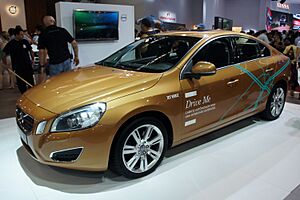
The UK government announced public trials of the LUTZ Pathfinder driverless pod. Tesla Motors rolled out its Autopilot software update, allowing cars to self-park and even "summon" themselves from parking spots.
Volvo Cars announced plans to lease 100 XC90 SUVs with "Level 3 automation" technology to people in Sweden. This technology lets drivers activate and deactivate autonomous mode. Volvo hopes this will help them reach their goal of having no one seriously injured or killed in a new Volvo by 2020.
In April 2015, a car designed by Delphi Automotive completed the first coast-to-coast journey across North America, driving itself for 99% of the distance.
Google announced that its driverless test vehicles had been involved in 14 minor accidents since 2009. The project leader said that all of these accidents were caused by human drivers in other cars who were distracted. This showed how important self-driving technology could be for safety.
2016

Volvo announced plans to test 100 self-driving XC90s in China and London.
A significant event occurred in May 2016 when a Tesla Model S, while using its Autopilot feature, was involved in a collision with a large truck. This led to a formal investigation by the National Highway Traffic Safety Administration (NHTSA) to examine the design and performance of automated driving systems.
In August 2016, Singapore launched the first self-driving taxi service as a pilot program.
Tesla announced that all its new cars would be built with the necessary hardware for full self-driving capability (SAE Level 5). This includes many cameras and sensors. The system would learn by processing data without taking action, preparing for future software updates that would enable full autonomy.
2017 Audi announced that its new A8 car would be fully self-driving at speeds up to 60 km/h, using its "Audi AI" system. This would have been the first production car to reach Level 3 autonomous driving, meaning the driver could safely turn their attention away from driving. However, this feature was never fully activated.
2018 In March 2018, there was a reported crash involving a self-driving vehicle and a pedestrian in Arizona. This led to more discussions about safety and how these vehicles operate.
The world's first fully electric self-driving bus, open to the public, was launched in Switzerland. In December 2018, Waymo launched the first commercial robotaxi service called "Waymo One" in the Phoenix area, allowing users to request a ride through an app.
2019 By May 2019, twenty-nine U.S. states had passed laws allowing autonomous cars.
Recent Developments (2020s)
2020 New rules for automated vehicles started to appear in Europe and at the United Nations. Tesla also released a "beta" version of its "Full Self-Driving" software to a small group of testers in the U.S. Many electric, autonomous buses also began to be launched for public transport around the world.
2021 Honda began leasing a limited edition of its Legend Hybrid EX sedans in Japan. These cars had newly approved Level 3 automated driving equipment, allowing drivers to take their eyes off the road in certain traffic situations.
Mercedes-Benz received approval in Germany for its Level 3 self-driving technology, called Automated Lane Keeping System (ALKS).
2022 Mercedes-Benz started selling its Drive Pilot system in Germany, which offers SAE Level 3 autonomy for its S-Class and EQS models.
In Japan, a company called eve autonomy launched the first SAE Level 4 autonomous transportation service at several factories and industrial sites. This service included special insurance for the autonomous driving system.
2023 On April 1, 2023, Japan's "Road Traffic Act" was updated to allow Level 4 self-driving. In June 2023, Mercedes-Benz USA received a permit in California to use its Drive Pilot system on some highways. This made Mercedes-Benz the first company allowed to sell or lease vehicles with an automated driving system to the public in California. This Level 3 system can operate on highways during the day at speeds up to 40 mph, but the driver must still be ready to take control.
Notable Projects
- The DARPA Grand Challenge (2004, 2005, 2007) were competitions that offered millions of dollars in prizes to teams that could create autonomous cars.
- The Google driverless car project has a test fleet of autonomous vehicles that have driven millions of miles.
- The EUREKA Prometheus Project (1987–1995) was a large European research project on autonomous vehicles.
- "CityMobil2" (2012–2016) was an EU-funded project that developed self-driving shuttles in Europe.
- "SIP-adus" (2014–2023) is Japan's national project that helped change laws to allow Level 3 driving on public roads.
- Israel has research efforts to develop autonomous border-patrol vehicles.
- The Oshkosh Corporation developed an autonomous military vehicle called TerraMax.
- Apple electric car project "Titan" (2014–2024) included work on autonomous systems.
- Uber Advanced Technologies Group (2015–2021) worked with Carnegie Mellon to develop autonomous cars.
- "nuTonomy" and other companies have been testing autonomous cars in Boston.
- "L3Pilot" (2017–2022) was a large project testing SAE Level 3 and Level 4 functions in passenger cars across Europe.
- "Avenue" (2018–2022) was an EU-funded project for self-driving shuttles in four European cities.
- "Torc Robotics" (2019– ) has been testing autonomous vehicles across the southeastern United States.
University Projects
- The ARGO vehicle and its successor BRAiVE are from the University of Parma's VisLab.
- Stanford's Dynamic Design Lab created Shelley, an Audi TTS designed for high-speed autonomous driving on a racetrack.
- Oxford University's "WildCat Project" created a modified vehicle capable of autonomous operation using many sensors.
- Oxford University's "RobotCar UK" project developed an inexpensive autonomous car that could switch between manual and autopilot on learned routes.
- "AutoNOMOS" is a project from the Free University of Berlin.
- Zeus is an autonomous vehicle system developed by students at the University of Toronto, which has won several competitions.
History of Self-Driving Cars Laws
Countries around the world are creating laws to allow and regulate self-driving cars.
- In December 2017, Norway passed a law allowing self-driving vehicles to be tested on public roads.
- In March 2018, France made it easier to experiment with self-driving cars on public roads.
- In 2018, the United Kingdom passed the Automated and Electric Vehicles Act 2018 to regulate these vehicles.
- In 2019, Japan updated its "Road Traffic Act" and "Road Transport Vehicle Act." These changes, which took effect in April 2020, allowed Level 3 self-driving cars on public roads and set up safety certification processes.
- In July 2021, France updated its road laws for automated vehicles. Also in 2021, Germany's Autonomous Driving Act came into effect, allowing Level 4 autonomous driving in specific areas on public roads.
- On April 1, 2023, Japan's updated "Road Traffic Act" officially allowed Level 4 self-driving.
- In June 2023, California issued a permit to Mercedes-Benz USA, allowing their Level 3 Drive Pilot system on some highways. This was a big step as it allowed the public to buy or lease vehicles with this automated system.
See also
- History of train automation


